The Air Force has detected the presence of a likely carcinogen at its three intercontinental ballistic missile bases, including unsafe levels of the chemicals at sites in North Dakota and Montana.
An effort to decontaminate those facilities is now underway.
The service said Aug. 26 that of 900 samples taken at missile facilities across Malmstrom Air Force Base, Montana; F.E. Warren AFB, Wyoming; and Minot AFB, North Dakota, 68 tested positive for polychlorinated biphenyls — a class of chemicals used in oils, electrical components, appliances and more until they were banned in 1979.
The discovery is part of a sweeping yearlong study, now about halfway done, to determine whether the airmen who manage America’s nuclear arsenal are at greater risk of cancer and other health impacts, like immune or reproductive system problems, as a result of their jobs.
The study, launched by Air Force Global Strike Command boss Gen. Thomas Bussiere in January, is examining the air, soil, water and physical surfaces of the above-ground missile alert facilities used by Air Force security personnel, cooks, maintainers and others who interact with the nuclear enterprise each day, and the underground launch control centers where airmen sit ready to fire missiles at a moment’s notice.
“Our airmen are charged with carrying out the nation’s most important mission, and they deserve a safe and clean work environment while they perform duties,” Bussiere said in a release.
To collect its samples, the Air Force in June and July wiped high-touch surfaces and places where contaminated equipment is now or was previously installed in each base’s alert facilities and launch control centers.
At F.E. Warren, nearly 6% of samples tested positive for PCBs. None registered levels high enough to be deemed unsafe by the U.S. Environmental Protection Agency.
At Malmstrom, 7% of samples tested positive for PCBs. Two samples exceeded the EPA threshold to require cleaning: one from alert facility “Hotel-01,” and another from alert facility “India-01.”
And at Minot, 10% of samples tested positive for PCBs. There, too, two samples surpassed the EPA’s safety threshold — both from alert facility “Delta-01.”
U.S. Environmental Protection Agency rules require cleanup of surfaces that contain more than 10 micrograms of PCB chemicals per 100 square centimeters, or an area about the size of a person’s palm. A microgram measures approximately one-millionth the weight of a paper clip, the Air Force said.
PCBs aren’t always easy to reach, like those that have turned up in places like the underside of electrical switch boxes, the service told Air Force Times.
All areas that tested positive for PCBs, regardless of how contaminated, are undergoing remediation, an Air Force spokesperson said.
Biohazard crews can clean each site within a day or two, and the Air Force is keeping airmen out of those locations until that work is done, the service said. That means shuffling airmen around to perform maintenance and other work in facilities where PCBs weren’t found, until it’s safer to return to areas where the carcinogens turned up.
Once PCB-positive areas are cleaned, the Air Force is retesting them to make sure they’re chemical-free.
As part of the wider study, the service will swab spots around its missile facilities three times over the course of a year to determine whether chemical exposure varies by season.
The service previously tried to rid its nuclear missile sites of PCBs in the 1990s; it’s unclear whether those scrubs were not comprehensive enough or if the chemicals resurfaced in the following decades.
The Air Force is also sampling the air, water and soil at its missile bases to search for multiple kinds of contamination, from pesticides to radon. No airborne PCBs were detected in the air samples, the service said.
While the Air Force isn’t issuing any specific recommendations to airmen who have worked at the affected facilities, it encourages current and former troops to talk to their health care providers if they have any symptoms of cancers like non-Hodgkin lymphoma or other ailments.
At least 268 troops who worked at nuclear missile sites have reported cancers, blood diseases and other illnesses over the past several decades, according to the Torchlight Initiative, an advocacy group comprised of former missileers and their families.
The Air Force is trying to push information on the cancer study as widely as it can across its nuclear missile community, parts of which fall outside of Air Force Global Strike Command. It relies on outside groups, like the Association of Air Force Missileers, to spread the word to those who have since separated or retired.
Bussiere has pledged to take further action as the cancer study yields more results.
Rachel Cohen is the editor of Air Force Times. She joined the publication as its senior reporter in March 2021. Her work has appeared in the Washington Post, the Frederick News-Post (Md.), Air and Space Forces Magazine, Inside Defense, Inside Health Policy and elsewhere.




